Understanding Generalization in ABA Therapy
Applied Behavior Analysis (ABA) therapy is a cornerstone in supporting individuals with autism, promoting meaningful behavior changes that improve communication, social skills, and independence. Central to the success of ABA programs is the concept of generalization — the critical ability for individuals to apply skills learned in therapy across varied real-life settings and situations. This article explores how generalization functions within ABA programs, its importance, key types, strategies to promote it, and the essential roles of trained professionals and caregivers.
What is Applied Behavior Analysis (ABA) Therapy and Who Provides It?
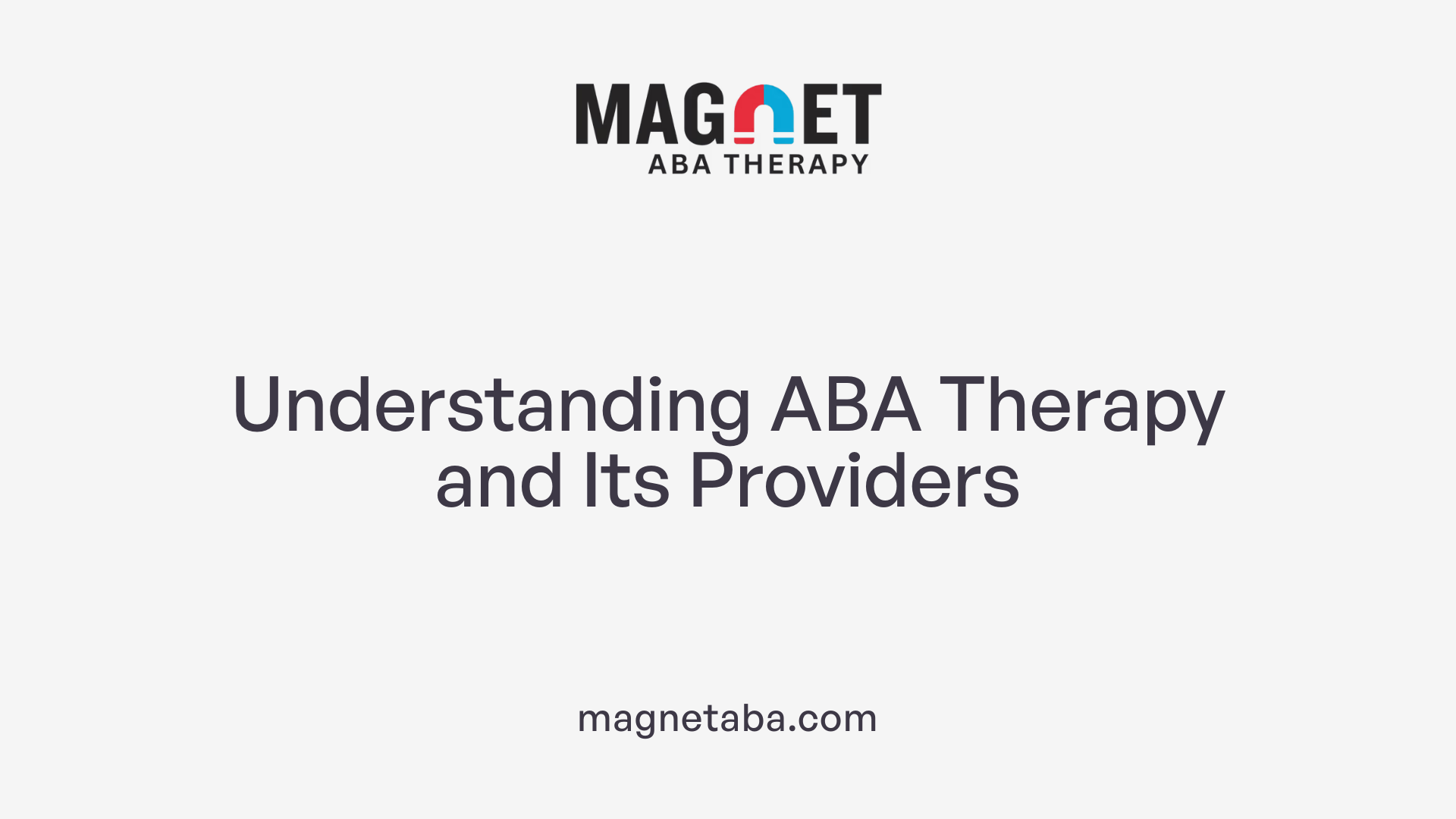
What is Applied Behavior Analysis (ABA) therapy, and how does it help individuals with autism?
Applied Behavior Analysis (ABA) therapy is a research-backed method that focuses on understanding how behaviors are influenced by the environment. It uses this knowledge to promote positive behavioral change, primarily for individuals with autism. The therapy aims to develop essential skills such as communication, social interactions, and daily living abilities while reducing behaviors that may be harmful or interfere with learning.
ABA programs are personalized to meet the specific needs of each individual. They involve techniques like reinforcement to encourage desired behaviors, prompting to help initiate actions, and systematic skill building. Progress is continuously tracked using data to adjust strategies and maximize effectiveness.
Extensive studies have shown that intensive and consistent ABA therapy can significantly improve language, social skills, cognitive abilities, and independence. It remains a leading, evidence-supported approach for enhancing the quality of life for those with autism spectrum disorder.
Who typically provides ABA therapy, and what qualifications do they have?
ABA therapy services are delivered by a range of trained professionals with various certification levels:
- Board Certified Behavior Analysts (BCBAs): These are master's level practitioners responsible for designing, overseeing, and adjusting individualized ABA treatment plans.
- Registered Behavior Technicians (RBTs): These paraprofessionals work directly with individuals under BCBA supervision to implement therapy protocols.
- Board Certified Assistant Behavior Analysts (BCaBAs): Often undergraduate-level certified practitioners who assist in service delivery and support.
- Behavior Therapist Assistants and other certified specialists: Individuals with specialized training support therapy sessions under supervision.
All providers undergo rigorous education, supervised fieldwork, and must pass certification exams to ensure competence in behavior analysis principles and ethical practices. In some regions, licensed behavior analysts (LBAs) with additional state credentials also provide ABA services.
This multi-tiered provider structure ensures a comprehensive and collaborative approach to delivering effective ABA therapy tailored to each individual's unique needs.
Core Techniques in ABA Therapy Supporting Behavioral Change

What are some common techniques used in ABA therapy to support behavioral changes?
Applied Behavior Analysis (ABA) therapy uses a variety of evidence-based techniques to encourage positive behavior changes and skill development. One foundational method is positive reinforcement, which motivates individuals by rewarding desirable behaviors, thereby increasing the likelihood of those behaviors recurring.
Another widely used technique is Discrete Trial Training (DTT). DTT breaks skills into small, manageable steps, teaching each one through repeated, structured trials. This approach helps learners focus and gradually build mastery.
ABA also employs prompting and fading, where therapists provide support cues initially and then slowly reduce them as the learner gains independence. This encourages skill acquisition without creating dependency.
More complex skills are taught using behavior chaining and task analysis. Here, tasks are broken down into sequences so learners can master each component systematically, eventually performing the whole chain independently.
In addition, techniques like modeling (demonstrating behaviors), natural environment teaching (embedding lessons in real-life settings), response cost, extinction (reducing unwanted behaviors by withholding reinforcement), and the ABC (Antecedent-Behavior-Consequence) method to analyze behavior patterns are utilized.
All interventions are tailored to individuals' unique needs, relying on ongoing data collection to track progress and fine-tune strategies. This personalized approach ensures effective behavior modification and skill acquisition, essential for fostering independence and functional communication.
Measuring Effectiveness: Tracking Progress in ABA Therapy
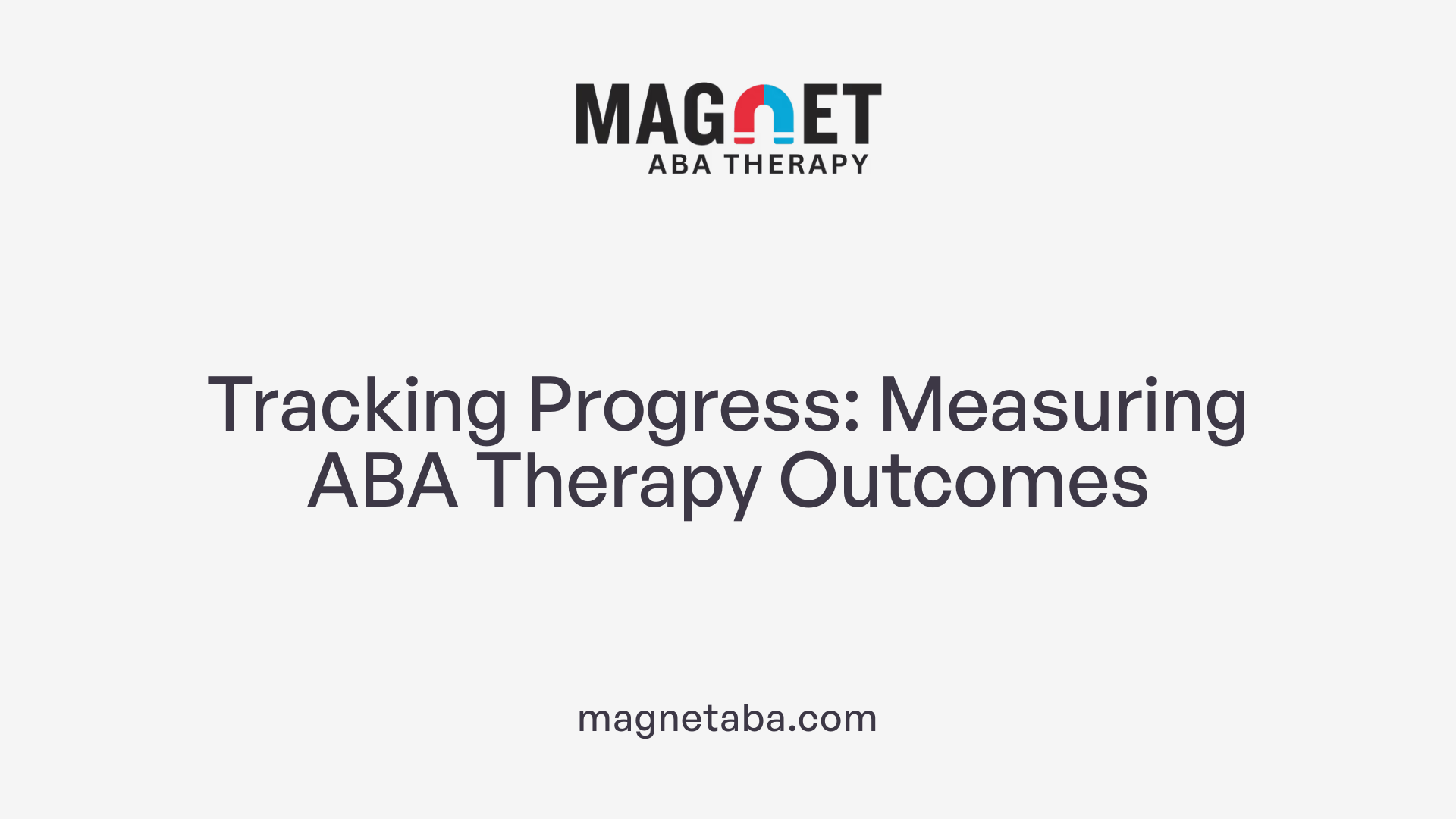
How is the effectiveness of ABA therapy measured in individuals with autism?
The effectiveness of Applied Behavior Analysis (ABA) therapy is measured primarily through continuous assessment methods tailored to individual goals. Data collection plays a central role in tracking progress. Therapists gather detailed information on skill acquisition, behavior reduction, and improvements in communication.
Certified behavior analysts (BCBAs) analyze these data trends routinely to determine if targeted behaviors are improving. Observable indicators of positive outcomes include increased communication abilities, enhanced social interaction, and growing independence in daily activities.
Progress monitoring involves:
- Frequent measurement of behaviors and skills
- Adjusting treatment plans based on data and caregiver feedback
- Using objective, quantifiable data to guide decisions
Regular assessments allow for timely modifications, ensuring therapy remains effective and responsive to the individual's evolving needs. Overall, data-driven evaluation combined with clinical expertise enables ABA therapy to focus on meaningful improvements that translate into real-world gains for individuals with autism.
Defining Generalization in ABA: Why It Matters

What Does Generalization Mean in ABA?
Generalization in Applied Behavior Analysis (ABA) refers to the ability of an individual, particularly children with autism, to transfer learned skills across various settings, people, and situations without requiring new teaching. It means that a behavior or skill taught in therapy isn’t limited to just the therapy room but can be applied in everyday life.
Why Is Generalization Important for Independent Functioning?
Generalization is essential because it supports the learner’s independence. Skills acquired are not just practiced in isolation but are successfully used in real-life scenarios such as home, school, and community environments. This ability improves social interactions, communication, and daily functioning, helping individuals lead fuller and more autonomous lives.
How Does Therapy Connect to Real-World Applications Through Generalization?
Generalization bridges the gap between controlled learning environments and the unpredictable real world. For example, a child taught to request help during therapy should be able to ask for assistance at home or in school. Therapists facilitate this by teaching skills across multiple settings and involving caregivers to reinforce skills consistently. This approach ensures that behaviors are meaningful and functional across the diverse environments a child encounters daily.
Types of Generalization: Stimulus, Response, and Maintenance
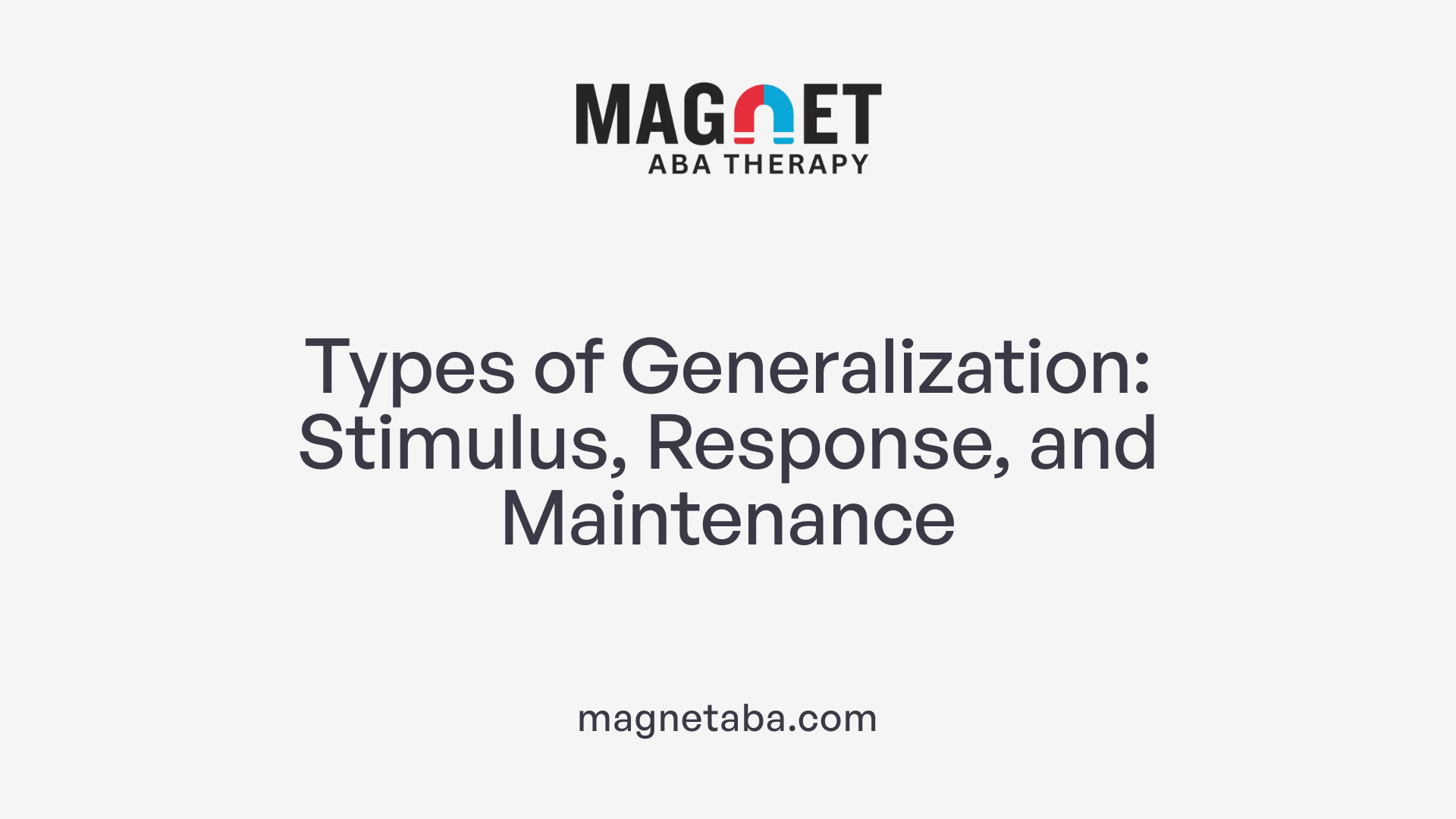
What is Stimulus Generalization?
Stimulus generalization occurs when an individual responds similarly to different but related stimuli. For example, a child taught to identify a red apple might also correctly identify a red ball as "red," even though the objects differ. This ability helps broaden learning beyond a single specific cue.
Understanding Response Generalization
Response generalization refers to the transfer of a learned behavior to functionally similar behaviors. For instance, if a child learns to request one preferred toy, they might generalize this skill by requesting other toys or preferred items. This enables flexible use of communication and problem-solving skills in various contexts.
Maintenance: Keeping Skills Over Time
Maintenance generalization involves retaining learned behaviors over extended periods without direct reinforcement. This means a child continues to use mastered skills independently across different settings and days after initial teaching sessions.
How These Types Support Consistency Across Contexts
Together, stimulus generalization, response generalization, and maintenance ensure that skills acquired during therapy are not limited to one situation. They allow children with autism to apply what they learn in therapy to real-world environments such as home, school, and the community, promoting independence and functional success.
These forms of generalization are crucial for bridging the gap between structured learning and everyday life, helping children navigate diverse situations confidently and effectively.
Strategies to Promote Generalization in ABA Programs
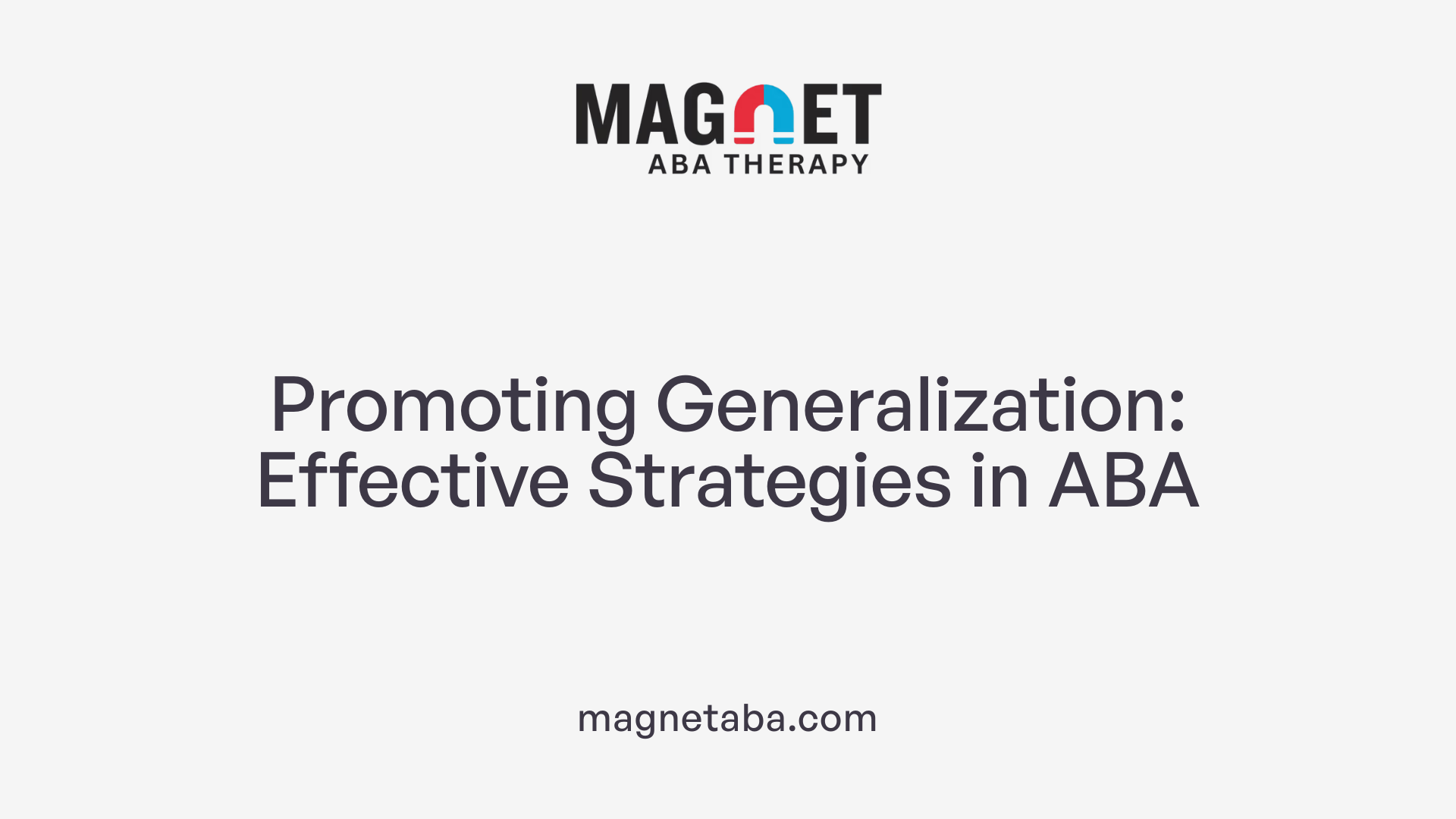
Teaching in Multiple Environments and Involving Different People
To encourage generalization, ABA therapists teach skills across various settings, such as therapy rooms, homes, schools, and community spaces. This approach helps learners apply skills in real-world contexts beyond the therapy session. Involving different people—teachers, family members, therapists—ensures that the skill is recognized and reinforced consistently.
Use of Varied Stimuli and Instructional Variability
Presenting learners with different examples and stimuli, like objects of various shapes, sizes, and colors, supports flexible thinking and helps skills transfer to new situations. Instructional variability, where teaching conditions and materials vary, promotes the learner's ability to respond appropriately even when circumstances change.
Techniques Such as Prompting, Fading, and Training Loosely
Prompts are used initially to guide correct responses, but over time, these prompts are gradually faded so the learner becomes independent. Training loosely involves accepting a wide range of correct responses rather than requiring perfection, which encourages flexible application of skills across scenarios.
Collaborating with Caregivers and Educators for Consistency
Caregivers and educators play a vital role by reinforcing skills outside therapy sessions. ABA programs include training families and teachers to maintain consistency, ensuring skills are practiced and supported across all environments. This collaboration builds confidence and independence in the learner.
By integrating these strategies, ABA programs maximize the transfer and maintenance of learned skills, contributing to more successful and meaningful outcomes for individuals with autism.
The Crucial Role of Caregivers and Educators in Generalization
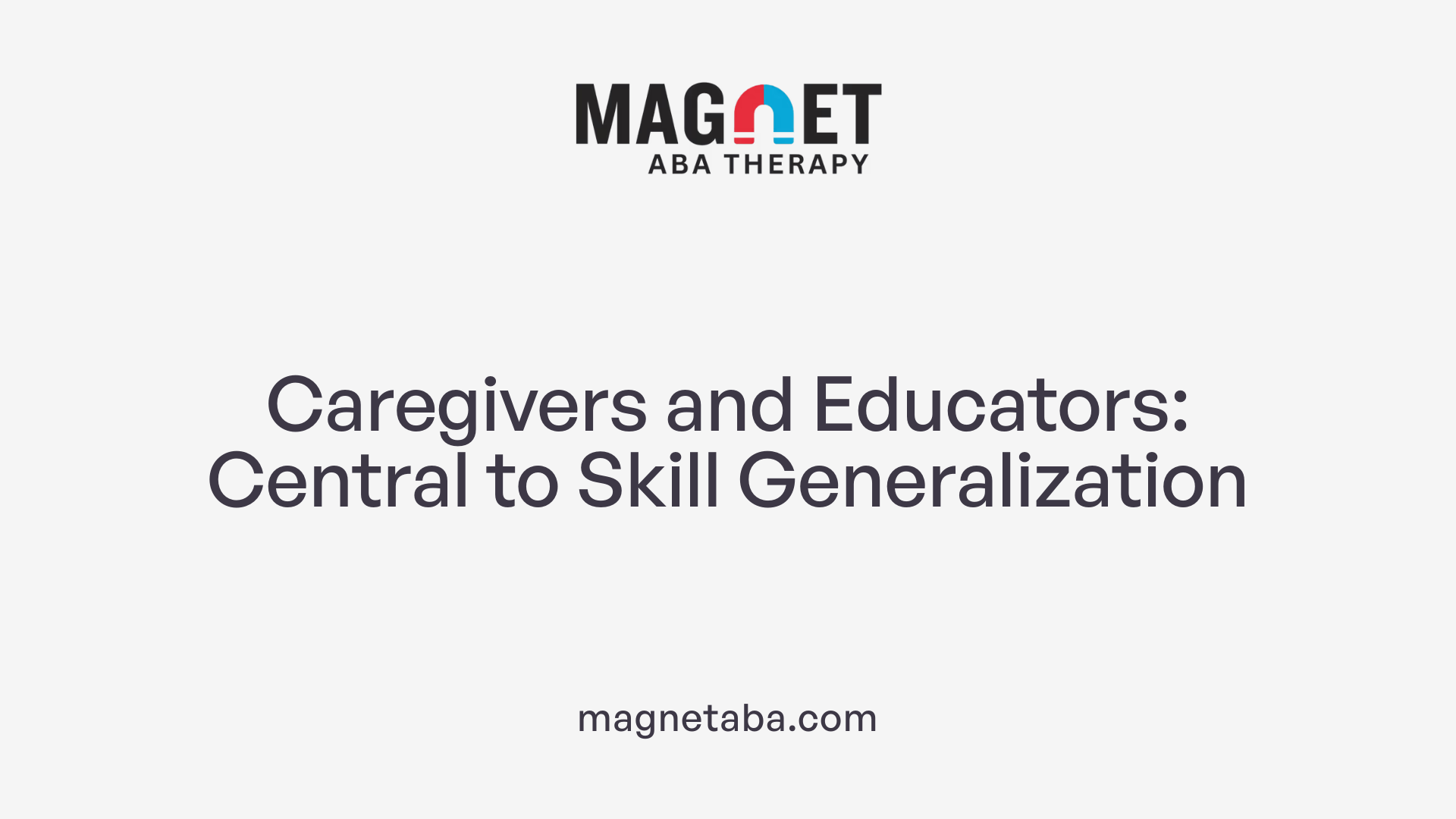
How parents and caregivers reinforce skills beyond therapy
Parents and caregivers play a vital role in promoting generalization by reinforcing skills learned during therapy sessions. By consistently practicing and encouraging these skills at home, they help children apply learned behaviors in natural settings. This reinforcement ensures that skills are not limited to the therapy room but become part of the child's daily routine.
Training caregivers to maintain consistency
Effective training for caregivers is essential to maintain consistency across different environments. Therapists work collaboratively with families to teach them how to implement strategies, use prompts appropriately, and gradually fade support as the child becomes more independent. This ongoing training empowers caregivers to support skill maintenance and generalization effectively.
Coordination between therapists, family, and educators
Successful generalization requires close coordination among therapists, family members, and educators. Clear communication and shared goals allow for consistent approaches across home, school, and community settings. Educators can incorporate the same teaching strategies and reinforce behaviors during the school day, while therapists provide guidance and adjustment of programs.
Impact on long-term success and independence
When caregivers and educators actively participate in promoting generalization, children are more likely to apply skills independently across multiple settings. This enhances their social interactions, functional abilities, and overall quality of life. Consistent reinforcement across environments is a cornerstone of long-term success in ABA therapy, facilitating greater independence for individuals with autism.
Examples of Generalization in Action: Real-Life Success Stories
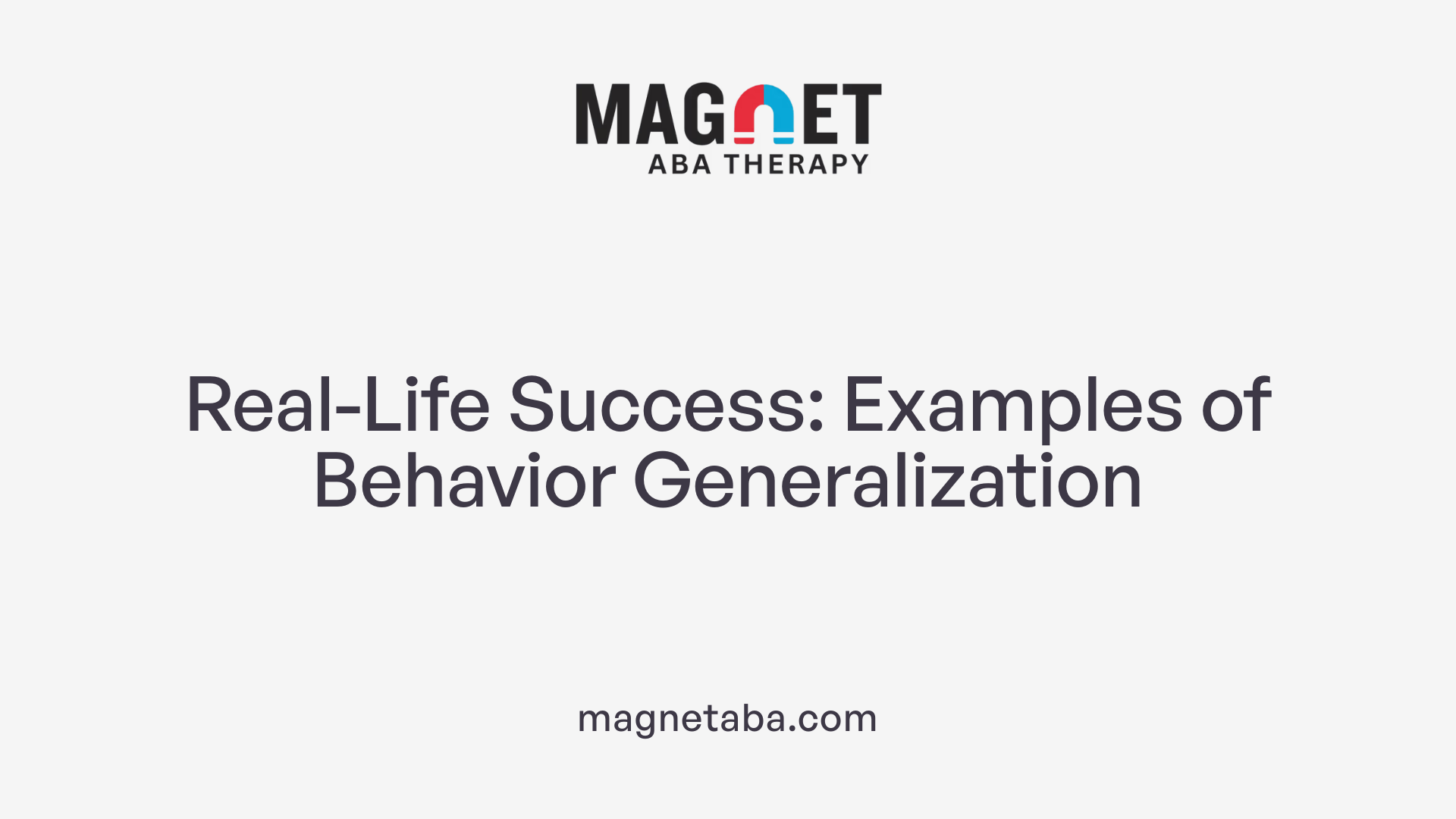
Instances of learners using skills across home, school, and community
Children receiving Applied Behavior Analysis (ABA) therapy often demonstrate the ability to use their learned skills far beyond the therapy session itself. For example, a child may learn to request help during therapy and then successfully apply this communication skill at home with family members, at school with teachers, and in community settings like a playground or store. This broad use highlights the effectiveness of generalization in real-world contexts.
Progression from therapy context to independent use of skills
Early in treatment, learners typically require prompts and support to use new skills. With consistent reinforcement and strategies like teaching in multiple environments and fading prompts, these skills become more independent. A child might initially need guidance to greet peers during therapy sessions but eventually initiates greetings spontaneously across different classrooms and social situations without prompting.
Positive effects on social interaction and daily functioning
Generalization supports improvements in social interactions by enabling children to initiate conversations, cooperate with peers, and navigate social routines successfully. Beyond social benefits, successfully generalized skills empower children to complete self-care tasks, follow instructions, and participate actively in their communities. These advancements contribute to increased independence, confidence, and quality of life.
Why Generalization is the Cornerstone of Successful ABA Therapy

Ensuring Skills are Functional and Meaningful Beyond Therapy
Generalization in Applied Behavior Analysis (ABA) is essential because it allows individuals with autism to apply the skills they learn in therapy across different settings, people, and situations. This means that rather than skills being limited to a therapy room, individuals can use them in real-life environments such as home, school, and community, making the learned behaviors more practical and impactful.
The Impact on Improving Quality of Life for Individuals with Autism
When children successfully generalize skills, they gain independence and confidence. For example, they can request help or follow instructions not only during therapy but also when interacting with family members or teachers. This broad use of skills enhances social interactions and overall functioning, significantly improving their quality of life.
Research Evidence Supporting Generalization’s Role in Outcomes
Studies underscore that generalization is fundamental to effective ABA therapy. Foundational research by Baer et al. (1968) and Stokes & Baer (1977) highlights generalization's crucial impact on making interventions efficient and successful. More recent evidence confirms that treatment outcomes depend heavily on the learner’s ability to utilize skills beyond the clinical setting.
How Early Intervention Leverages Generalization for Long-Term Gains
Early ABA intervention programs that emphasize generalization can lead to better developmental trajectories. Introducing skills in multiple environments and involving caregivers early enables children to transfer and maintain these skills over time, offering long-lasting benefits. This approach sets the stage for continuous growth and success across a spectrum of social and functional domains.
Making ABA Therapy Work: The Essential Nature of Generalization
Generalization is more than a concept in ABA therapy — it is the bridge that connects structured learning in clinical settings to meaningful, independent living in everyday environments. By understanding its types, promoting it through varied strategies, and involving caregivers and educators, ABA programs ensure that individuals with autism not only acquire essential skills but also confidently apply them across life’s diverse scenarios. This holistic approach enhances communication, independence, and social success, making ABA therapy profoundly effective and transformative. As ongoing research and practice continue to underscore, supporting generalization is indispensable to achieving the ultimate goal of ABA: improving the lives of those with autism in real, lasting ways.
References
- What is Generalization And How to Implement it in ABA
- Generalization in ABA Therapy for Skill Expansion
- Understanding Generalization of Skills in ABA Therapy
- Generalization Definition ABA: Understanding Its ...
- Generalization: What it Means and Why it Matters
- Applied Behavior Analysis (ABA)
- How to Measure ABA Therapy's Effectiveness
- Applied Behavior Analysis (ABA)
- Who Qualifies for ABA Therapy: Eligibility Guide
- Types Of ABA Therapy Jobs And Their Degree Requirements












